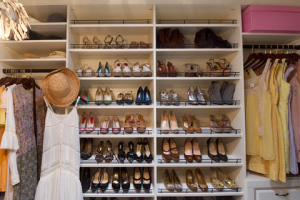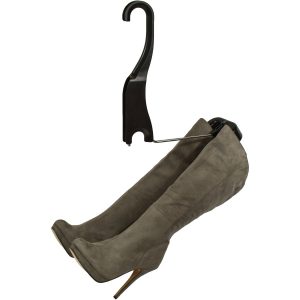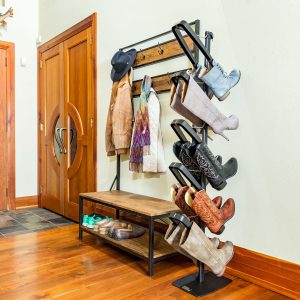
With the exception of shoe-phobic people who only own a few pairs, most of us struggle with keeping our footwear tidy and in decent condition. But it’s actually not difficult to get into a more organized routine of storing shoes and boots. There are some considerations to keep in mind, but as with most things, the process is about creating good habits and sticking to them!
1. KEEP YOUR SHOES AND BOOTS CLEAN
The first thing to remember is that all boots and shoes need to be put away clean. If you don’t care for your boots and shoes properly, it doesn’t matter where or in what manner you store them because they’ll soon be ruined! Make sure they are fully dry when you put them away. Wipe or brush off any lingering dirt and check them over carefully for damage.
2. CHOOSE THE RIGHT ENVIRONMENT
If at all possible, choose a place that’s cool, dark and dry for your footwear collection. Extreme temperatures and damp will hurt the fiber of your shoes and boots, and sunlight may cause them to bleach out. Don’t store your shoes and boots with mothballs or any other chemical pest repellent. Over time they will take on unpleasant odors that will be very hard to remove. Using cedar chips is a much better alternative.
3. HAVE A SORTING SYSTEM
Go through your shoes and boots carefully and sort them by type and season. There’s no reason to keep sandals close at hand during winter, or boots in the summer, especially if your space is limited. Out-of-season footwear should be examined, cleaned, and kept in the best climate controlled area of your home so that it will be in excellent condition when summer or winter rolls around again.
How do you tell if a shoe or boot is better suited for spring, fall, or winter?
Well, beyond the practical reason of comfort, shoes flatter seasonal clothing differently. Obviously, sandals are better worn with lighter clothes – whether simple leisure clothing or lightweight fabric dresses – in warmer weather. Cowboy boots work for any season! Many other styles that are more purpose-built in nature are suitable for particular conditions or activities rather than seasons, such as riding boots, hunting boots, and rain boots.
More fashion oriented boots are most appropriate when the weather is colder, but during those periods of serious snow, as well as the accompanying salt, delicate leather and suede are not the best choices. Loafers are a great choice for fall. They fit back-to-school styles and can also coordinate with scarves and gloves for those cooler football game nights. When the weather finally warms up again in spring, it’s time to get out lighter footwear – flats, slip-on, or sports shoes – and enjoys the outdoors again.
4. FIX OR GET RID OF YOUR OLD BOOTS
Once you’ve sorted out your footwear by season and purpose, go over everything again for a condition. Toss anything that’s in bad shape, or have it repaired. How do you know if it’s worth repairing? Well, an old rule of thumb is: if a repair costs less than half the price of new shoes, repair them. In many cases, the repair may be as simple as using a bit of shoe polish and elbow grease to get a scuffed looking pair of shoes looking like new again.
Often people will choose to repair footwear for reasons other than monetary value. If you have a favorite pair of shoes or a pair of very comfortable shoes you’ve finally broken in perfectly, putting a new heel on them to keep them around longer is worth the investment.
5. BOOT RACKS ARE BEST
Once you’ve decided which pairs of shoes and boots you will be using currently and which ones you’ll be storing, then you can begin putting them away. Neither shoes nor boots should be stored in piles or on top of each other. It’s bad for them, and it makes dressing more complicated if you’re searching for the other boot.
There are many different shoe storage solutions, including shoe racks, shoe cubbies, and shoe ladders. It’s helpful to work with a professional organizer to decide which solutions will work best for your space. This will allow you to create ideal solutions for storing footwear you wear every day, footwear you wear only on special occasions, and footwear that is especially delicate.
If you are planning to store your footwear for any length of time, stuff them with acid-free paper or shoe trees so they will hold their shape. Boots are best stored with the Boot Butler boot rack. Boot Butler is designed to store and support all kinds of boots, from fashion to cowboy, in a way that maintains their shape and keeps them organized and accessible.
Here’s a short video of how it works:
While storing your footwear may be more involved for people with large wardrobes, it doesn’t have to be difficult. It’s all about maintaining both condition and access. Any storage solution that doesn’t accomplish both seamlessly is not one you should consider for this crucial storage project!


